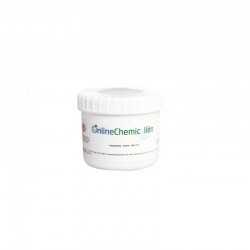€ 7,99 (incl. btw)
Ijzersulfaat, ook bekend als ferrosulfaat, is een krachtig product dat zowel als meststof als mos verwijderen kan worden gebruikt. Het is een tweewaardig ijzerzout van zwavelzuur met diverse toepassingen. Het hoge...
€ 7,38 (incl. btw)
Krijt poeder of ook wel Calciumcarbonaat genoemd, is een veelzijdig product dat gebruikt kan worden voor verschillende toepassingen. Gebruikt als vulmiddel in de industrie Kan dienen als grondstof voor de productie...
€ 4,99 (incl. btw)
Talkpoeder is een veelzijdig en natuurlijk product dat voor tal van toepassingen kan worden gebruikt. Het heeft een sterk vochtabsorberende werking en is ideaal tegen zweet- en jeukplekken. Het kan ook worden gebruikt...
€ 7,99 (incl. btw)
Waterstofperoxide foodgrade 3% of ook wel hydrogen peroxide is een Effectief, milieuvriendelijk en veelzijdig. Deze hydrogen peroxide is van foodgrade kwaliteit, en kan dus gebruikt worden in de voedselverwerking...
€ 8,99 (incl. btw)
Waterstofperoxide foodgrade 12% of ook wel hydrogen peroxide is een Effectief, milieuvriendelijk en veelzijdig. Deze hydrogen peroxide is van foodgrade kwaliteit, en kan dus gebruikt worden in de voedselverwerking...
€ 6,49 (incl. btw)
| Hoeveelheid | Korting | Eenheid prijs |
|---|---|---|
| 2 | 10% | € 5,84 |
| 4 | 20% | € 5,19 |
Waterstofperoxide 3% of ook wel hydrogen peroxide is een Effectief, milieuvriendelijk en veelzijdig. Deze anorganische verbinding van zuurstof en water is het perfecte reinigingsmiddel. Dit milieuvriendelijke product...
€ 7,99 (incl. btw)
| Hoeveelheid | Korting | Eenheid prijs |
|---|---|---|
| 2 | 10% | € 7,19 |
| 4 | 20% | € 6,39 |
Waterstofperoxide 12% of ook wel hydrogen peroxide is een Effectief, milieuvriendelijk en veelzijdig. Deze anorganische verbinding van zuurstof en water is het perfecte reinigingsmiddel. Dit milieuvriendelijke product...
€ 749,00 (incl. btw)
Soda - Natriumsulfaat is een veelzijdig product dat wordt gebruikt voor een verscheidenheid aan toepassingen. Het bestaat uit natriumsulfaat, een anorganisch zout dat oplosbaar is in water.Additief in wasmiddelen...
€ 2.151,38 (incl. btw)
Natriumsilicaat, ook wel bekend als waterglas, is een veelzijdig chemisch product dat in verschillende industrieën wordt gebruikt. Dit product komt witte vaste stof in 40x25kg zakken. Is redelijk goed oplosbaar in...
€ 5,99 (incl. btw)
Bakingsoda, ook wel natriumbicarbonaat of zuiveringszout genoemd, is een veelzijdig en nuttig product dat voor verschillende toepassingen kan worden gebruikt. Deze witte kristallijne stof is niet alleen een populair...
€ 1.599,00 (incl. btw)
Magnesiumchloride / MgCl2 is een chemische verbinding die veelvuldig gebruikt wordt in verschillende industrieën vanwege zijn diverse eigenschappen en toepassingen. Landbouw & tuinbouw Milieu toepassingen...
€ 9,99 (incl. btw)
| Hoeveelheid | Korting | Eenheid prijs |
|---|---|---|
| 2 | 10% | € 8,99 |
Ontdek de krachtige werking van Natriumhydroxide ook wel bekend onder noah of caustic soda. Wordt veelgebruikt als ontstopper voor hittebestendige afvoeren. Bestel nu onze Natrium Hydroxide en bespaar op dure...
€ 5,99 (incl. btw)
| Hoeveelheid | Korting | Eenheid prijs |
|---|---|---|
| 2 | 10% | € 5,39 |
| 4 | 20% | € 4,79 |
Magnesiumsulfaat poeder, ook bekend als bitterzout of epsom zout, is een veelzijdig product dat voor verschillende toepassingen gebruikt kan worden. Agrarische toepassingen:Verhoogt het magnesiumgehalte in de grond...
€ 6,39 (incl. btw)
| Hoeveelheid | Korting | Eenheid prijs |
|---|---|---|
| 2 | 10% | € 5,75 |
Calciumchloride is een krachtig vocht onttrekkend middel dat in verschillende sectoren en toepassingen wordt gebruikt. Het is effectief in het reguleren van de vochtigheid en het voorkomen van schade aan materialen....
€ 7,99 (incl. btw)
Ijzersulfaat, ook bekend als ferrosulfaat, is een krachtig product dat zowel als meststof als mos verwijderen kan worden gebruikt. Het is een tweewaardig ijzerzout van zwavelzuur met diverse toepassingen. Het hoge...
€ 4,99 (incl. btw)
Talkpoeder is een veelzijdig en natuurlijk product dat voor tal van toepassingen kan worden gebruikt. Het heeft een sterk vochtabsorberende werking en is ideaal tegen zweet- en jeukplekken. Het kan ook worden gebruikt...
€ 5,99 (incl. btw)
Bakingsoda, ook wel natriumbicarbonaat of zuiveringszout genoemd, is een veelzijdig en nuttig product dat voor verschillende toepassingen kan worden gebruikt. Deze witte kristallijne stof is niet alleen een populair...
€ 7,38 (incl. btw)
Krijt poeder of ook wel Calciumcarbonaat genoemd, is een veelzijdig product dat gebruikt kan worden voor verschillende toepassingen. Gebruikt als vulmiddel in de industrie Kan dienen als grondstof voor de productie...
€ 8,99 (incl. btw)
Luchtontvochtiger - vochtslurper navulling is een effectieve oplossing tegen vocht en muffe geuren.Perfect voor vochtbestrijding in ruimtes met slechte of geen ventilatie, zoals een caravan, schuur, kelder, zolder,...
€ 8,99 (incl. btw)
Waterstofperoxide foodgrade 12% of ook wel hydrogen peroxide is een Effectief, milieuvriendelijk en veelzijdig. Deze hydrogen peroxide is van foodgrade kwaliteit, en kan dus gebruikt worden in de voedselverwerking...
€ 7,99 (incl. btw)
Waterstofperoxide foodgrade 3% of ook wel hydrogen peroxide is een Effectief, milieuvriendelijk en veelzijdig. Deze hydrogen peroxide is van foodgrade kwaliteit, en kan dus gebruikt worden in de voedselverwerking...
€ 7,99 (incl. btw)
| Hoeveelheid | Korting | Eenheid prijs |
|---|---|---|
| 2 | 10% | € 7,19 |
| 4 | 20% | € 6,39 |
Waterstofperoxide 12% of ook wel hydrogen peroxide is een Effectief, milieuvriendelijk en veelzijdig. Deze anorganische verbinding van zuurstof en water is het perfecte reinigingsmiddel. Dit milieuvriendelijke product...
€ 6,49 (incl. btw)
| Hoeveelheid | Korting | Eenheid prijs |
|---|---|---|
| 2 | 10% | € 5,84 |
| 4 | 20% | € 5,19 |
Waterstofperoxide 3% of ook wel hydrogen peroxide is een Effectief, milieuvriendelijk en veelzijdig. Deze anorganische verbinding van zuurstof en water is het perfecte reinigingsmiddel. Dit milieuvriendelijke product...
€ 8,96 (incl. btw)
| Hoeveelheid | Korting | Eenheid prijs |
|---|---|---|
| 2 | 10% | € 8,06 |
| 4 | 20% | € 7,17 |
Glycerine 99,5% is een veelzijdig en plantaardig wondermiddel voor huidverzorging en andere toepassingen. Het is een heldere stof met een sterke geur van kamfer. Glycerine is een lichaamseigen stof en komt voor in de...
€ 9,94 (incl. btw)
| Hoeveelheid | Korting | Eenheid prijs |
|---|---|---|
| 2 | 10% | € 8,95 |
| 4 | 20% | € 7,95 |
Isopropanol 99,9% / IPA / isopropyl alcohol - Veilige en effectieve ontvetter en oplosmiddel. Krachtige ontvetter: Isopropyl alcohol 99,9% lost snel vuil en vet op zonder oppervlakken aan te tasten. Geschikt voor...
€ 5,99 (incl. btw)
| Hoeveelheid | Korting | Eenheid prijs |
|---|---|---|
| 2 | 10% | € 5,39 |
| 4 | 20% | € 4,79 |
Magnesiumsulfaat poeder, ook bekend als bitterzout of epsom zout, is een veelzijdig product dat voor verschillende toepassingen gebruikt kan worden. Agrarische toepassingen:Verhoogt het magnesiumgehalte in de grond...
€ 9,99 (incl. btw)
| Hoeveelheid | Korting | Eenheid prijs |
|---|---|---|
| 2 | 10% | € 8,99 |
Ontdek de krachtige werking van Natriumhydroxide ook wel bekend onder noah of caustic soda. Wordt veelgebruikt als ontstopper voor hittebestendige afvoeren. Bestel nu onze Natrium Hydroxide en bespaar op dure...
€ 7,19 (incl. btw)
| Hoeveelheid | Korting | Eenheid prijs |
|---|---|---|
| 2 | 10% | € 6,47 |
| 4 | 20% | € 5,75 |
Borax poeder ( natriumtetraboraat ) is een natuurlijk en veelzijdig middel voor diverse huishoudelijke taken. Met een zuiverheid van 99,9% en van technische kwaliteit, is dit borax poeder van hoge kwaliteit en...
€ 7,99 (incl. btw)
| Hoeveelheid | Korting | Eenheid prijs |
|---|---|---|
| 2 | 10% | € 7,19 |
| 4 | 20% | € 6,39 |
Waterstofperoxide 12% of ook wel hydrogen peroxide is een Effectief, milieuvriendelijk en veelzijdig. Deze anorganische verbinding van zuurstof en water is het perfecte reinigingsmiddel. Dit milieuvriendelijke product...
€ 5,99 (incl. btw)
Bakingsoda, ook wel natriumbicarbonaat of zuiveringszout genoemd, is een veelzijdig en nuttig product dat voor verschillende toepassingen kan worden gebruikt. Deze witte kristallijne stof is niet alleen een populair...
€ 8,99 (incl. btw)
Waterstofperoxide foodgrade 12% of ook wel hydrogen peroxide is een Effectief, milieuvriendelijk en veelzijdig. Deze hydrogen peroxide is van foodgrade kwaliteit, en kan dus gebruikt worden in de voedselverwerking...
€ 4,99 (incl. btw)
Talkpoeder is een veelzijdig en natuurlijk product dat voor tal van toepassingen kan worden gebruikt. Het heeft een sterk vochtabsorberende werking en is ideaal tegen zweet- en jeukplekken. Het kan ook worden gebruikt...
€ 7,19 (incl. btw)
| Hoeveelheid | Korting | Eenheid prijs |
|---|---|---|
| 2 | 10% | € 6,47 |
| 4 | 20% | € 5,75 |
Borax poeder ( natriumtetraboraat ) is een natuurlijk en veelzijdig middel voor diverse huishoudelijke taken. Met een zuiverheid van 99,9% en van technische kwaliteit, is dit borax poeder van hoge kwaliteit en...
€ 7,99 (incl. btw)
Waterstofperoxide foodgrade 3% of ook wel hydrogen peroxide is een Effectief, milieuvriendelijk en veelzijdig. Deze hydrogen peroxide is van foodgrade kwaliteit, en kan dus gebruikt worden in de voedselverwerking...
€ 10,99 (incl. btw)
| Hoeveelheid | Korting | Eenheid prijs |
|---|---|---|
| 2 | 10% | € 9,89 |
| 4 | 15% | € 9,34 |
Oxaalzuur kopen ? Oxaalzuur kristallen zijn een krachtig reinigingsmiddel met een zuiverheid van 99,5% en van technische kwaliteit. Ze zijn speciaal ontworpen voor industriële toepassingen zoals het ontweren van hout...
€ 6,49 (incl. btw)
| Hoeveelheid | Korting | Eenheid prijs |
|---|---|---|
| 2 | 10% | € 5,84 |
| 4 | 20% | € 5,19 |
Waterstofperoxide 3% of ook wel hydrogen peroxide is een Effectief, milieuvriendelijk en veelzijdig. Deze anorganische verbinding van zuurstof en water is het perfecte reinigingsmiddel. Dit milieuvriendelijke product...

Kaliumjodide Jodium 99.9% puur/zuiver
€ 19,99 (incl. btw)
Recente artikelen



































































